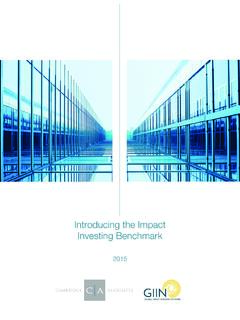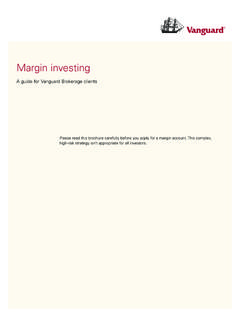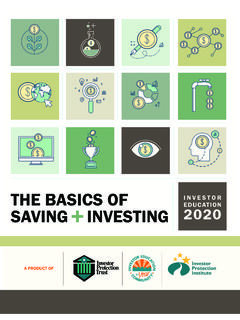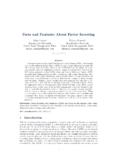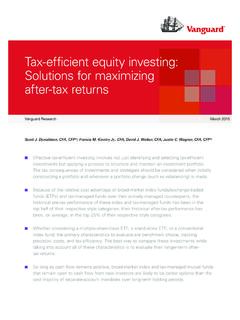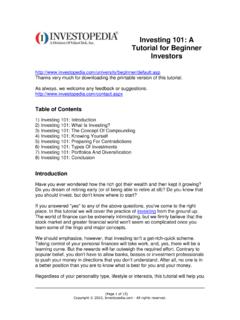Transcription of Investing in smallholder agriculture for food security ...
1 Investing in smallholder agriculturefor food securityA report byThe High Level Panel of Expertson food security and NutritionJune 20136 HLPE REPORT2 HLPE Steering Committee members (June 2013) MS Swaminathan (Chair) Maryam Rahmanian (Vice-Chair) Catherine Bertini Tewolde Berhan Gebre Egziabher Lawrence Haddad Martin S. Kumar Sheryl Lee Hendriks Alain de Janvry Renato Maluf Mona Mehrez Aly Carlos Perez del Castillo Rudy Rabbinge Huajun Tang Igor Tikhonovich Niracha Wongchinda HLPE Project Team members Pierre-Marie Bosc (Team Leader) Julio Berdegu Mamadou Go ta Jan Douwe van der Ploeg Kae Sekine Linxiu Zhang Coordinator of the HLPE Vincent Gitz This report by the High Level Panel of Experts on food security and Nutrition (HLPE) has been approved by the HLPE Steering Committee.
2 The views expressed do not necessarily reflect the official views of the Committee on World food security , of its members, participants, or of the Secretariat. This report is made publicly available and its reproduction and dissemination is encouraged. Non-commercial uses will be authorised free of charge, upon request. Reproduction for resale or other commercial purposes, including educational purposes, may incur fees. Applications for permission to reproduce or disseminate this report should be addressed by e-mail to with copy to Referencing this report: HLPE. 2013. Investing in smallholder agriculture for food security .
3 A report by the High Level Panel of Experts on food security and Nutrition of the Committee on World food security , Rome. 3 Contents FOREWORD .. 7 SUMMARY AND RECOMMENDATIONS .. 10 Main observations .. 10 Recommendations .. 16 Recommendations to the CFS .. 18 INTRODUCTION .. 19 1 smallholder agriculture AND INVESTMENTS .. 23 What is smallholder agriculture ? .. 23 Key features of smallholder agriculture .. 23 The challenges of defining smallholder agriculture .. 25 The picture of smallholder agriculture in the world .. 26 Smallholders form a highly heterogeneous and dynamic sector .. 31 Investments .. 32 A sustainable livelihoods framework for understanding investments.
4 32 Investments and productivity .. 33 Smallholders are the main investors .. 34 Constraints on Investing in smallholder agriculture .. 35 Persistent poverty, lack of access to assets and compounded risks .. 35 Market failures .. 38 Imbalances of power in economic and political relations .. 39 Towards a typology of constraints on investment in smallholder agriculture .. 41 2 WHY INVEST IN smallholder agriculture ? .. 45 The roles of smallholder agriculture in achieving food security and sustainable development .. 45 food security .. 46 food processing, food chains and link to consumers .. 49 smallholder organizations and access to markets.
5 50 Smallholders, pluriactivity and the rural non-farm economy .. 51 Role in economic growth .. 52 Environmental significance .. 53 Social and cultural importance .. 54 Structural transformations and smallholder agriculture .. 54 Pathways to economic and agricultural structural transformations .. 55 Drivers of structural transformations .. 58 Developing options for smallholder agriculture within global transformations .. 62 3 WHAT TYPES OF INVESTMENTS? .. 65 On-farm investments by smallholders in productive assets .. 65 Increasing productivity .. 65 Developing resilience .. 67 Models of production adapted to the conditions of smallholder agriculture .
6 67 Reducing drudgery of work particularly for women .. 68 Collective investments to overcome limited assets .. 69 Collective investments in productive assets .. 69 Investing in risk management strategies .. 70 4 Investing in enabling markets .. 72 Improving smallholders access to input markets .. 72 Investing to develop markets that favour smallholders .. 72 Increasing smallholders access to financial services .. 73 Contract farming and investments: the economic and institutional conditions for contract farming as an inclusive process .. 75 The role of smallholder organizations in facilitating market access.
7 79 Investing in enabling institutions .. 80 Investing in public goods provision .. 80 Investing in research for development .. 81 Consolidating the capacities of governments and public services .. 82 Social protection for investments .. 83 Securing tenure rights to enable investments .. 84 Investing to build effective and representative smallholders organizations .. 85 4 smallholder agriculture : A STRATEGIC APPROACH FOR INVESTMENTS .. 87 A National smallholder Investment Strategy based on a vision for smallholder agriculture .. 87 Elements of a renewed policy agenda .. 88 Improving access to assets .. 88 Improving access to existing and new markets.
8 90 Strengthening institutions: from smallholder organizations to the public sector .. 91 REFERENCES .. 93 ACKNOWLEDGEMENTS .. 105 EDITORIAL NOTE .. 105 APPENDICES .. 106 A1 List of 81 countries used in the calculations for figures in Chapter 1 .. 106 A2 Abbreviations for countries used in Figure 8 .. 106 A3 Examples of policy instruments available to address the different elements that influence food security at household level .. 107 A4 The HLPE project cycle .. 110 5 List of Figures Figure 1 Flows of income and sources of investments in an agricultural smallholding .. 24 Figure 2 Repartition of holdings by class area in the 81-country subset of FAO-WCA.
9 27 Figure 3 Regional diversity of holding size patterns in the 81-country subset of FAO-WCA .. 27 Figure 4 Repartition of the agricultural holdings, and of total agricultural area, per class of holding size in Africa for the 14 countries of the WCA-FAO subset of Africa, and within the whole European Union (EU-27) .. 29 Figure 5 Assets/capitals of a livelihood and what enables them .. 33 Figure 6 Diversity of smallholders situations mapped against assets-, markets- and institutions-related constraints to investment .. 42 Figure 7 Per-hectare and per-holding value of smallholders production, as compared to large-scale farming production, in different regions of Argentina.
10 48 Figure 8 Structural transformation across countries at a certain period, and past trajectories for some specific countries .. 56 Figure 9 Activity ratios (top) and yearly cohorts entering labor markets (bottom) for selected regions (1950-2050) .. 59 Figure 10 Evolution of the number and mean size of holdings in Brazil, the United States of America, India and France (1930 2000) .. 60 Figure 11 Cultivated area per agricultural worker (top), production per hectare (middle) and production per agricultural worker (bottom) by world regions (1961-2003) .. 61 Figure 12 Structural transformations (1970 2007) .. 63 Figure 13 HLPE project cycle.










